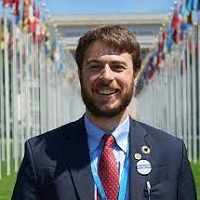
“Especially if you’re a vet tech, you’ve got access to a huge audience of people, and you’re regularly interacting with the community. There’s a really big opportunity to become an expert on One Health, and help educate the public about it.”
Dr. Neil Vezeau, Technical Advisor and Project Manager for the One Health Commission
Human health is closely linked to the health of animals and the health of our shared environment. Today, humans and animals interact more closely than ever before. More than half of all diseases people get are zoonotic, meaning they can spread between animals and humans.
Meanwhile, humans are traveling more quickly and more frequently between different environments, and increasing changes in climate and land use are affecting animal habitats and movements, causing further disruption. The connections between human, animal, and environmental health have never been more important.
The cyclical effects of the modern world and their resultant health threats require a sustainable and unified approach. One Health is that approach: one that crosses sectors, disciplines, and jurisdictions to balance the health of people, animals, and ecosystems. With origins that trace back to the veterinary world, One Health has grown into a worldwide movement supported by the Centers for Disease Control and Prevention (CDC), the World Health Organization (WHO), and many more.
January is One Health Awareness Month. It’s an opportunity to spread awareness about the interconnected realities of our shared world, and also a chance to build capacities for the One Health approach in individuals and organizations across the globe. Read on to learn more about One Health and how it’s making a difference.
Meet the Expert: Neil Vezeau, DVM, MPH

Dr. Neil Vezeau is technical advisor and project manager for the One Health Commission. As an undergraduate, he majored in both animal science and microbiology, and minored in emerging global disease. During this time, he co-founded the nation’s second chapter of Veterinarians Without Borders and the Iowa One Health Conference. He conducted animal science and clinical research, with honors research in antimicrobial resistance (AMR).
Since 2017, Dr. Vezeau has participated in multiple efforts advocating for more One Health coordination in the US. He served as a founding member and president of the International Student One Health Alliance (ISOHA). Now serving as an ISOHA Trustee, Dr. Vezeau helps build capacity for students working for One Health globally. He also continues work on AMR-related policy and gender in veterinary medicine.
What Is One Health?
The connections between human, animal, and environmental health are not new, but they are constantly changing. Historically, expansions in land use by humans, especially into forested areas, brought more interactions with mosquitos and different methods of disease transfer; interconnected shipping routes spread the Black Plague in addition to the common rat. Today’s globalized world has drawn the human, animal, and environmental domains even closer together. Collaboration between those domains is the key to a healthier, more sustainable world.
“A variety of governmental entities, and some private sector entities, have adopted a One Health approach,” Dr. Vezeau says. “Since the outbreak of Covid-19 worldwide, there’s been an explosion in One Health. It’s being mentioned in new stories, in scientific articles, in whitepapers, and everything in between.”
One Health is a conceptual framework that prioritizes collaboration, communication, and coordination, and it manifests in measurable and tangible actions. In addition to strategic planning and team-based conversations, there are budgeting, logistics, data-sharing, and personnel considerations required to build and support the infrastructure necessary to work between domains. This is an effort that scales from the personal all the way to the international—and it’s catching on.
“We’re seeing an increased level of understanding of how different elements of health affect one another,” Dr. Vezeau says. “The barriers between human medicine, veterinary medicine, and environmental health domains are breaking down. The barriers between nations collaborating on this are coming down, too, and bridges are being built in their place.”
One of the most concrete examples of implementing One Health is the Tripartite Zoonoses Guide (TZG). Jointly developed by the Food and Agriculture Organization of the United Nations (FAO), the World Organization for Animal Health (WOAH), and the WHO, it provides a toolkit to assist countries in achieving sustainable and functional collaboration at the human-animal-environment intersection.
Zoonotic diseases are only one area of application for One Health. Other priorities include antimicrobial resistance; food safety and security; environmental contamination; climate change; and the human-animal bond. These efforts not only bring together experts from different subject matter domains, but they also bring together diverse individuals from different socioeconomic and ethnoracial groups. Going further, One Health bridges rural and urban communities, national and international agencies, and all different industries.
“We’re trying to include people from those human, animal, and environmental health domains to make sure that we’re getting a holistic picture of exactly what’s happening in the world of health dynamics,” Dr. Vezeau says.
The Future for One Health
In December 2007, representatives of 111 countries and 29 international organizations met for the International Ministerial Conference on Avian and Pandemic Influenza. At that meeting, the One Health approach was put forth as a critical part of pandemic preparedness and human security. Fifteen years later, the message is reaching its most receptive audience yet.
A One Health Act was introduced into the US Senate in 2021. While the bill was sent back to committee, it still had lasting effects: a House Appropriations Committee Report directed the CDC to create a national One Health framework that would combat the threat of zoonotic diseases and advance emergency preparedness in the US. It also outlined the development of a federal One Health coordination approach, paving the way for One Health work done across the federal government.
“We’re also seeing One Health being adopted more and more by a variety of large international organizations like the WHO and the entire UN system,” Dr. Vezeau says. “There’s an increased recognition that the animal, human, and environmental health domains play into one another, which is a very important part of the increasingly complex world in which we live.”
Personal advocacy is also important. Veterinary professionals and students in veterinary medicine and veterinary technology can be influential in spreading awareness of One Health. Social media posts, face-to-face conversations, and attending or forming One Health groups on campus can all have a significant impact.
“Even just signing up for newsletters and staying involved and engaged in the movement helps,” Dr. Vezeau says. “Especially if you’re a vet tech, you’ve got access to a huge audience of people, and you’re regularly interacting with the community. There’s a really big opportunity to become an expert on One Health and help educate the public about it. It’s about getting people to see that the world doesn’t work in these traditional silos. We have to break that idea down, both on a personal and a systemic level.”
Resources for One Health Awareness Month
To learn more about One Health, and how you can get involved, check out some of the resources below.
- One Health Commission: The One Health Commission is a globally focused organization dedicated to implementing One Health and One Health actions worldwide. They host a wide range of One Health resources, including their global strategic action plans and an aggregated list of the social media accounts of other One Health organizations.
- International Student One Health Alliance (ISOHA): Connecting students worldwide interested in One Health, ISOHA serves as an umbrella for student organizations related to One Health. They offer resources on how to join a One Health club, and how to start your own.

